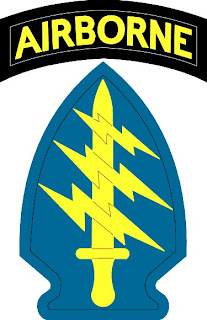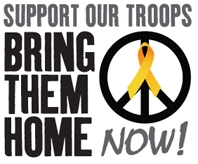The Kit-Kat Club
Further musings on the New Direction in Iraq--embedding U.S. advisors for the "make benefit" (if I may borrow from Borat, as our policy seems just as absurd) of Iraqi forces.
It should be noted that a large portion of the U.S. military machine has been embedded in Iraq for 3 1/2 years. Apparently, to no effect other than the 2,800 U.S. servicemen killed and over 21,000 wounded. Embedded or not, more U.S. advisers will not set a hopelessly precarious house of cards aright. Buzzwords and jargon will not change the reality on the ground.
The New York Times ran an article today on the expanded Army training for advisors to the Iraqi security forces. "The Army has handed the mission to Major General Carter F. Ham, who has a previous stint as a commander in Iraq." And what did he command? Of course, a U.S. combat unit.
So what exactly qualifies Ham to run the advisory program? Wouldn't it make more sense to appoint an overseer having actual advisory experience in Iraq?
Well, it would...if any of them were ever promoted to the rank Major General. The Army rewards the career track devotees and not the side-lined reservists and advisers of the early Iraq adventure. I'm not denigrating or attacking early advisers, just pointing out that no top grads from West Point ever fill these positions.
Looking at the Army institutionally, how many Medal of Honor (MOH) recipients in RVN were advisers? The rewards are few and the hazards great. Advisers don't win the MOH; they get Bronze Stars for service or achievement. Line infantry members do. The recognition and money is in killing.
The article is standard pap, save for one telling comment from Maj. Gen. Ham. "As a matter of Army policy, staffing the (advisory) teams is now a higher priority for Army personnel officers than filling the empty slots in units on alert to deploy in Iraq and Afghanistan." Clearly, the Army is robbing Peter to pay Paul.
If the Army can't properly perform both missions, that suggests U.S. options are severely limited. This is not a formula for success. The program may get MG Ham promoted, but it's not going to unwind the cat's cradle called Iraq and Afghanistan.
I'll bring a 100+-year-old formula to bear upon the advisory question, one used by the U.S. military in previous conflicts. In the Indian Wars, indigenous warriors were placed in U.S. Army units as scouts (the Kit Carson Scouts); same-same, Filipino scouts until 1946. In 1950, the Army embedded Koreans into U.S. Army units. Same in RVN with former NVA soldiers.
In Korea, they were called KATUSA's (Korean Attached To U.S. Army), and in RVN, they were called Kit Carson Scouts. All these programs were great successes. Former Filipino scouts and Korean Katusa's became prominent in their respective armies after the U.S. stepped down.
Why doesn't the U.S. Army incorporate Iraqis and Afghanis into our units? Two per rifle squad has proven a successful mix. That is one indigenous per fire team. This is the only correct way to embed for advisory purposes.
It should be noted that a large portion of the U.S. military machine has been embedded in Iraq for 3 1/2 years. Apparently, to no effect other than the 2,800 U.S. servicemen killed and over 21,000 wounded. Embedded or not, more U.S. advisers will not set a hopelessly precarious house of cards aright. Buzzwords and jargon will not change the reality on the ground.
The New York Times ran an article today on the expanded Army training for advisors to the Iraqi security forces. "The Army has handed the mission to Major General Carter F. Ham, who has a previous stint as a commander in Iraq." And what did he command? Of course, a U.S. combat unit.
So what exactly qualifies Ham to run the advisory program? Wouldn't it make more sense to appoint an overseer having actual advisory experience in Iraq?
Well, it would...if any of them were ever promoted to the rank Major General. The Army rewards the career track devotees and not the side-lined reservists and advisers of the early Iraq adventure. I'm not denigrating or attacking early advisers, just pointing out that no top grads from West Point ever fill these positions.
Looking at the Army institutionally, how many Medal of Honor (MOH) recipients in RVN were advisers? The rewards are few and the hazards great. Advisers don't win the MOH; they get Bronze Stars for service or achievement. Line infantry members do. The recognition and money is in killing.
The article is standard pap, save for one telling comment from Maj. Gen. Ham. "As a matter of Army policy, staffing the (advisory) teams is now a higher priority for Army personnel officers than filling the empty slots in units on alert to deploy in Iraq and Afghanistan." Clearly, the Army is robbing Peter to pay Paul.
If the Army can't properly perform both missions, that suggests U.S. options are severely limited. This is not a formula for success. The program may get MG Ham promoted, but it's not going to unwind the cat's cradle called Iraq and Afghanistan.
I'll bring a 100+-year-old formula to bear upon the advisory question, one used by the U.S. military in previous conflicts. In the Indian Wars, indigenous warriors were placed in U.S. Army units as scouts (the Kit Carson Scouts); same-same, Filipino scouts until 1946. In 1950, the Army embedded Koreans into U.S. Army units. Same in RVN with former NVA soldiers.
In Korea, they were called KATUSA's (Korean Attached To U.S. Army), and in RVN, they were called Kit Carson Scouts. All these programs were great successes. Former Filipino scouts and Korean Katusa's became prominent in their respective armies after the U.S. stepped down.
Why doesn't the U.S. Army incorporate Iraqis and Afghanis into our units? Two per rifle squad has proven a successful mix. That is one indigenous per fire team. This is the only correct way to embed for advisory purposes.











1 Comments:
Propably for the same reason that there never will be any serious embedding ever: The US has no intelligence, and would leave itself open for enemy infiltration. Its the same reason the Iraqi forces are given second grade equipment, wich is propably a *great* moralebooster, hoho. "Why cant I get a proper flakvest and some night-goggles, sir?" Shut up, youre Iraqi, nobody cares.."
Post a Comment
<< Home